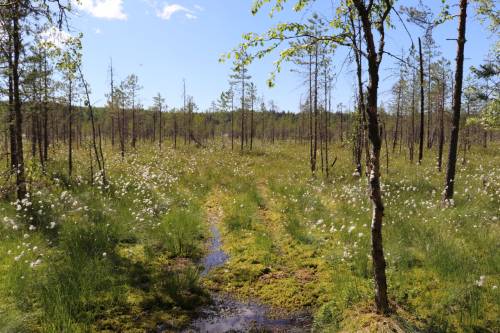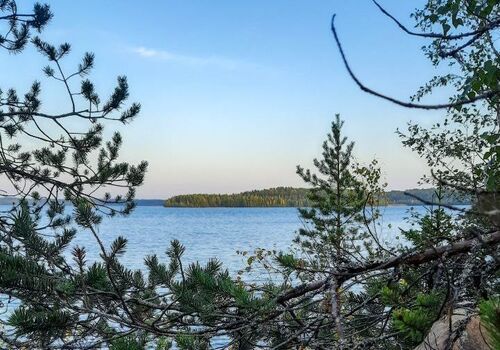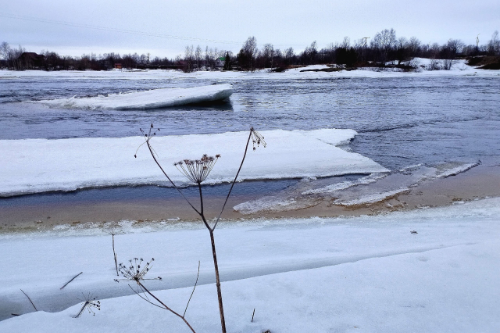Peatlands play a great role in our planet’s carbon balance. They sequester carbon dioxide and store carbon, thus neutralizing it. Mires occupy nearly a third of the territory of Karelia and the paludification process is ongoing.
Global warming and international climate agreements have rendered research on the role of natural ecosystems in the carbon balance ever more topical. Russia is creating a unified natural system for monitoring climate-active substances, including greenhouse gases. Their emissions are being actively studied by specialists at Karelian Research Centre’s institutes as well.
The Laboratory for Greenhouse Gas Monitoring at DMR KarRC RAS was established in 2022 within the Science and Universities national project. It primary objective is estimation of the carbon budget in natural and drained peatland ecosystems of the Northwest Russian boreal zone.
Scientists will collect and analyze field data to estimate carbon pools in boreal peatland ecosystems, greenhouse gas emissions, carbon leaching with water from peatlands, probability of carbon input from precipitation.
Head of the Laboratory Elizaveta Linkevich, Cand.Sci. (Chem.), told about the current activities and plans for 2023 at DMR Learned Council meeting. In particular, scientists have already chosen the first area to be studied – the 63 ha Blizkoye mire, situated in the Kivach Strict Nature Reserve. Greenhouse gas measurements there will be done by the closed-chamber method, using a special station for analyzing system-wide CO2 and methane fluxes.
The researchers will identify the factors influencing greenhouse gas emissions: anthropogenic, climatic, seasonal, etc. Peatland soils will be sampled to cover the entire depth and surface area of the mire, water samples will be collected, and the effects of seasonality and climate on the deposit’s major physicochemical characteristics will be assessed.
– We plan to pin down the relationship between peat-forming plants and the process of greenhouse gas emissions from the peatland surface and from the peat column. Techniques for structural group analysis of peatland soils will be elaborated, carbon distribution will be assessed, and correlations of greenhouse gas parameters with the main physicochemical characteristics and climatic conditions will be detected, – Elizaveta Linkevich shared.
Scientists will employ modern physicochemical techniques for greenhouse gas monitoring and measurement.
News

December 30, 2022
A new laboratory, for greenhouse gas monitoring, has been established at the Karelian Research Centre RAS. It will be part of the Department for Multidisciplinary Research (DMR). Laboratory staff will work to estimate the carbon balance in natural and drained peatland ecosystems of Karelia.
See also:

July 7, 2025
A successful introduction: the zander has settled down in Lake Sundozero and continues to spread
Scientists of the Institute of Biology KarRC RAS have published the results of long-term observations over the population of the zander (or pikeperch) introduced to Lake Sundozero more than a half-century ago. They confirm the species has become naturalized. Maintaining the population requires regulation of harvesting, protection during spawning, and tending of spawning grounds.
Scientists of the Institute of Biology KarRC RAS have published the results of long-term observations over the population of the zander (or pikeperch) introduced to Lake Sundozero more than a half-century ago. They confirm the species has become naturalized. Maintaining the population requires regulation of harvesting, protection during spawning, and tending of spawning grounds.

June 26, 2025
Ice-related phenomena on rivers emptying into the White Sea now last three weeks less than 60 years before
Ice on northern rivers now forms later while ice-off occurs earlier. Karelian scientists confirmed this having analyzed 64 years of marine and meteorological data from the estuaries of rivers draining into the White Sea along its western coast. Climate change has bit three weeks off the ice-covered period on these rivers. The reductions have been the most significant in the last 30 years, aligning with global warming trends in Arctic water bodies.
Ice on northern rivers now forms later while ice-off occurs earlier. Karelian scientists confirmed this having analyzed 64 years of marine and meteorological data from the estuaries of rivers draining into the White Sea along its western coast. Climate change has bit three weeks off the ice-covered period on these rivers. The reductions have been the most significant in the last 30 years, aligning with global warming trends in Arctic water bodies.

June 23, 2025
Citizen science and web technologies help researchers study insects of Karelia
More than 30 insect species not encountered in Karelia previously have been revealed by entomologists from KarRC RAS during their expeditions and using data communicated by active participants of the iNaturalist portal – an open platform for collecting biodiversity data.
More than 30 insect species not encountered in Karelia previously have been revealed by entomologists from KarRC RAS during their expeditions and using data communicated by active participants of the iNaturalist portal – an open platform for collecting biodiversity data.



